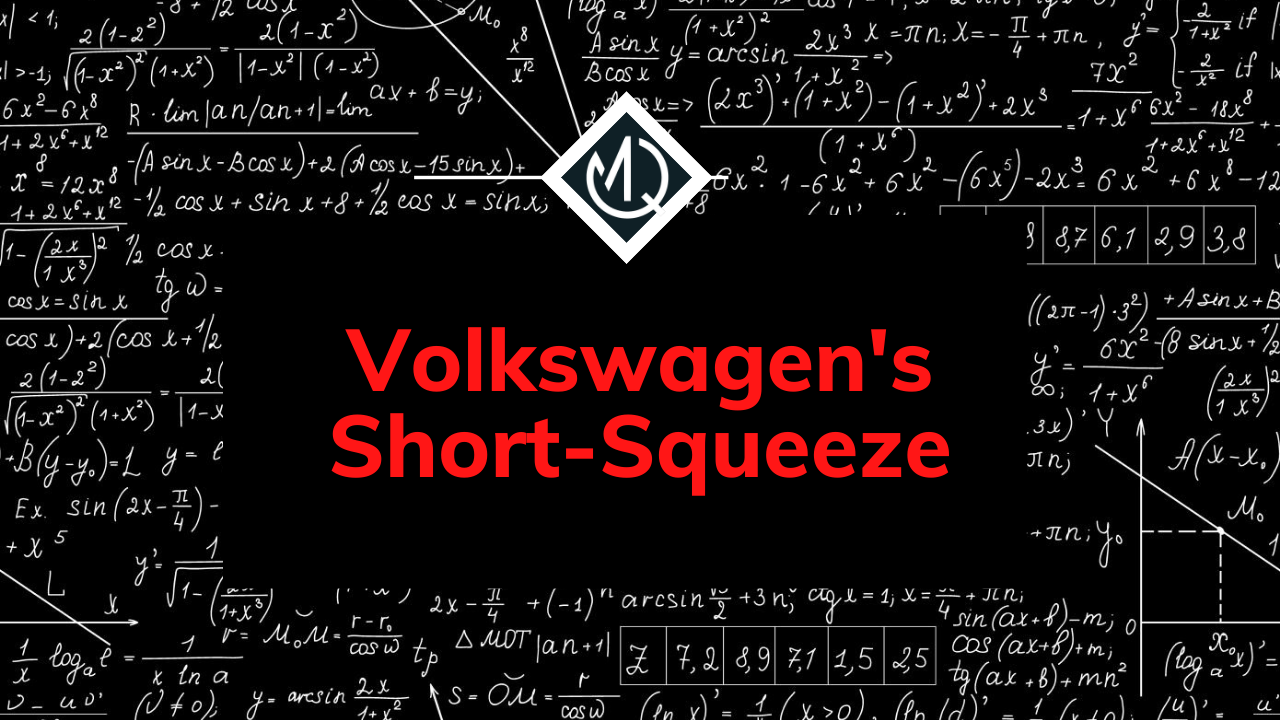As we all probably know, the year 2008 stood out for being a year full of important events that went down in the history of the financial markets. Although surely not as remembered as the sub-prime crisis, Volkswagen’s Short-Squeeze is still remembered as one of the most important and interesting Short-Squeezes ever. In this article, I will try to cover the events and concepts necessary to successfully understand what occurred during the Volkswagen Short-Squeeze and why it was so important.
Required Concepts for understanding Volkswagen’s Short-Squeeze
In order to understand what happened during Volkswagen’s Short-Squeeze, we first have to understand two important concepts: short-selling and short-squeezes.
What is Short-Selling?
Short-Selling is an operation in which a loan of shares is requested from a third party (generally a broker) in order to be able to sell them, and later repurchase them at future date at a lower price than the one at which the operation began.
When selling an asset that we borrowed, an open position will be generated that at some point we must close.
It can be used as a method of speculation for assets that we believe will drop in price. Additionally, short-selling can also be used as a hedging method for our portfolio by shorting a share that we hold by a certain percentage.
To start short selling, the counterparty will charge us interest while the position is open and will require us to leave certain guarantees, which can be liquid balance or other assets. This guarantee is called Margin.
Example of Shot-Selling
Let’s imagine that we decide to short a stock that is currently trading at $100.43. Once the short position is initiated there are two possible scenarios:
- The asset in which the short-selling began has fallen in price. That is to say that at the time of closing our position the price is, for example, $60.8. Therefore, our profit amounts to $39.5 (minus broker commissions).
- The chosen asset has appreciated and is trading at a higher price, for example, at $141.20. At that time we must decide whether to close the position and realize the losses ($40.77 per share plus broker commissions) or to remain short on the stock. If we decide not to close it and the asset continues to rise in price, the broker may forcefully close the position or ask us to replace the guarantees.
When choosing our short-selling strategy, it is vital to highlight two important factors:
- Our market timing: suppose we decide to close a trade at a loss and the asset then drops in price as we initially speculated. In such a scenario, will not make any profit whatsoever.
- Our risk management: in order to be able to maintain the position until the end of our strategy without the broker making a margin call.
What is a Short-Squeeze?
As we mentioned in the first section, once we want to close our position we must repurchase the asset. But let’s imagine that before we decide to do so, an unexpected event occurs in the market, be it a good quarterly balance sheet presentation or some news that has a positive impact on the asset. This will make our vision of the asset change, so we might be inclined to repurchase the stock to limit our potential losses. But what would happen if we are not the only short sellers who want to close their position on the asset?
This can create a bottleneck of people buying back the asset, leading to the market having three different types of demands on the stock:
- Those who wish to have the asset in their portfolio, that is, the usual market demand.
- Those who want to close their short-selling position.
- Those who are speculating that a “Short-Squeeze” will occur.
The short-squeeze is a buying run on the asset at any price in order to close the short position.
The short-squeeze is a buying run on the asset at any price in order to close the short position.
In order to detect them we must know how to calculate and the meaning of few additional fundamental concepts:
- Short interest: this value will indicate the number of all the company’s shares that are short selling. If we don’t contextualize it, it is difficult to interpret it, but it will help us understand the next concept.
- Short Float: (Short interest / Shares float), this ratio indicates the percentage of the number of shares that are in a short-selling position over the number of shares tradable in the market. Let us remember that “Shares float” are all the shares that are negotiable in the stock market, unlike “Shares Outstanding” which are all the authorized shares, but not necessarily being publicly traded in the market.
- Days to cover (also called short interest ratio): (short interest/average of the shares that are traded on the market in one day). This ratio represents the number of days. In other words, how long it would take if all the short sellers wanted to close their respective positions on the asset.
All markets usually publish this information once a month, but NASDAQ publishes it fortnightly on its website www.nasdaqtrader.com.
An important factor to take into account that increases the chances of a short-squeeze is a low share of floating stocks. Stocks with a low share float are much more volatile.
With these concepts covered, we can finally proceed to detail the 2008 Volkswagen Short-Squeeze!
Volkswagen’s Short Squeeze
In 2008, one of the biggest short-squeezes in history took place, in which Volkswagen’s stock increased from $210 to its historical maximum of $1,070 in a matter of days and, at a given time, was the most valuable company in the world.
A key factor leading to the short-squeeze was due to Porsche. The automotive company Porsche was interested in acquiring Volkswagen and was therefore buying its shares in large batches since 2005. As a consequence, as of that year, Volkswagen’s share price began an upward trend.
From this, three different types of short-sellers on Volkswagen participated in the market:
- Large investment funds considered Volkswagen to be overvalued, which is why they began to position themselves short.
- One strategy used by fund managers was to buy preferred shares (that is, they do not have the right to vote, but pay a higher dividend) and position themselves short in ordinary shares (with the right to vote, but with a lower dividend) with which the net position was zero, but they benefited from the dividends received.
- Some fund managers were interested in having Porsche in their portfolios, but this indirectly implied also having Volkswagen, therefore they were short on the latter in order to hedge their position on Volkswagen.
Timeline of Volkswagen’s Short-Squeeze
- June 10, 2008: Purchases by Porsche began to intensify, reaching a total holding of 42.6%. In addition to this, the German state of Lower Saxony held another 20% of Volkswagen shares, therefore the company’s free float was shrinking.
- October 26, 2008: The breaking point finally occurs when Porsche announces its intention of buying another 31.5% of Volkswagen stock options, thus reducing the percentage of the company’s free float to less than 6%. Taking into account that until that moment the short interest float was 12.8%, with the announcement it was discovered that the number of shares in short-sale was greater than the circulating supply.
- October 27, 2008: The investment funds that were in a short position had to repurchase shares to close the operation, but there simply was not enough liquidity for all of them to do it concurrently. Now the funds had to repurchase their shares competing with the indices that also had to buy Volkswagen to correctly weight its index and the traders who had detected that the short-squeeze was going to occur. This caused the price to shoot up more than 300% in just two days, reaching $1070.
Not only were the short-sellers who had to repurchase Volkswagen shares at ridiculous prices in order to close their position affected, but also the large indices such as the DAX (indices of the largest companies in Germany). The latter had to buy Volkswagen shares and sell other assets in order to continue replicating and correctly weighting their indices.
- August 20, 2009: Once everything settled down, Porsche stood out as the big winner of the event, given that it not only carried out the Volkswagen merger in 2009 as it had been planning but also during the days of the short-squeeze, their options were appreciated and they managed to sell a large part at a profit of over 500%.
Frequently Asked Questions (FAQ)
Are Short-Squeezes Legal?
Although on certain occasions regulators temporarily restrict the possibility of shorting assets in order to prevent short-squeezes from being generated, these are legal as long as market manipulation practices are not incurred. In addition, the possibility of being able to short generates important benefits for markets in general:
- Short-selling provides liquidity since the asset is constantly being bought and sold to open or close positions.
- Short-Selling allows different market visions to be acted upon.
- Short-Selling serves as a hedge to manage risk.
What are other famous Short-Squeezes?
Since 2020, the founder of Chewy ($CHWY) Ryan Cohen was interested in the GameStop company. He believed that it could change its business model, with lead to him making partial purchases with the aim of being able to acquire it.
The market had a bearish view of GameStop due to coronavirus (among other causes), given that the company’s business model was to sell physical games. Thus, GameStop became the most shorted stock in the market.
By identifying these fundamental facts and what we learned in the last section, we understand that we are in the presence of the ideal conditions that lead to a short-squeeze.
On January 9, 2021, the short-squeeze began in which the price increased more than 800% in a matter of 5 days, going from $48 to a maximum of $434, causing hedge funds such as Melvin Capital to go bankrupt.



No responses yet